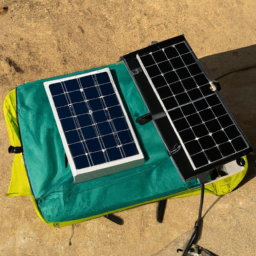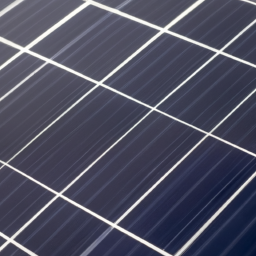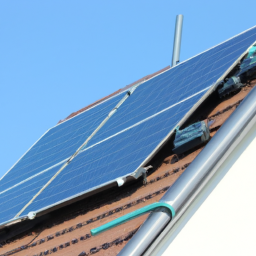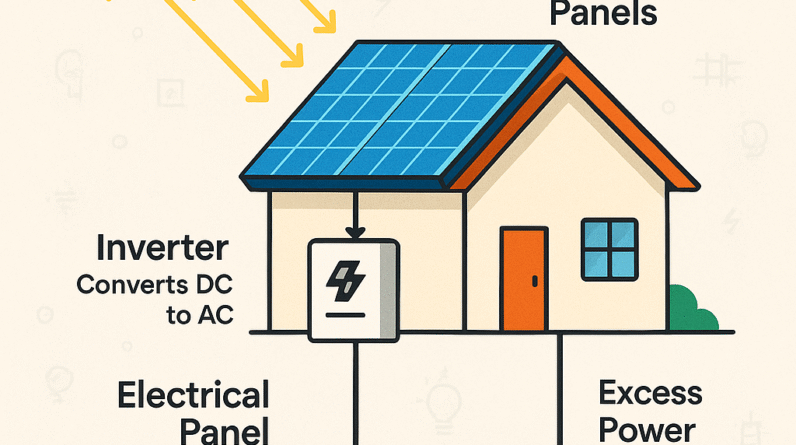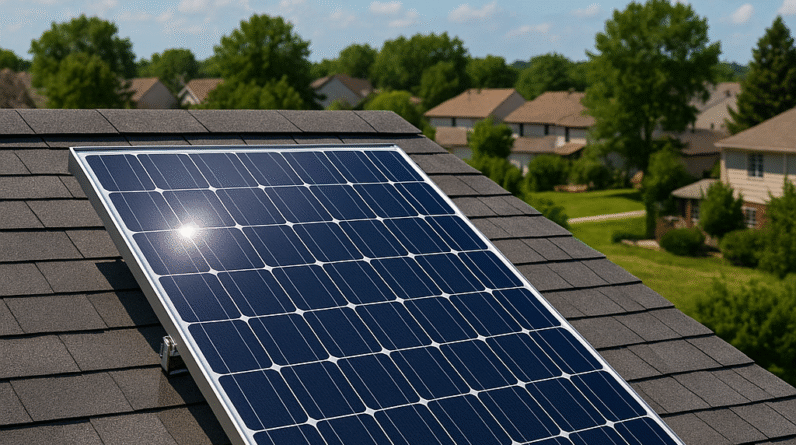
Do Solar Panels Work Well In Winter?
Do Solar Panels Work Well In Winter? Are you wondering if solar panels are as effective during the winter months? Well, the answer is a resounding yes! Despite the chilly temperatures and shorter daylight hours, solar panels continue to generate electricity and provide you with energy. While their output might be slightly lower compared to the warmer months, advancements in technology have made winter solar panels highly efficient. So, don’t let the snow and cold hold you back from embracing solar energy; it’s still a reliable and eco-friendly option all year round.

This image is property of images.unsplash.com.
Efficiency of solar panels in winter
Solar panels are a smart and sustainable choice for generating electricity, but many people wonder how well they perform during the winter months. The efficiency of solar panels can be influenced by various factors, including temperature, snow cover, and the type of panels used. In this article, we will explore the effect of these factors on solar panel performance in winter, as well as measures to improve their efficiency. We will also discuss the impact of reduced energy production in winter, cold weather considerations for solar panel installation, advancements in solar panel technology for winter use, and the cost-effectiveness of solar panels during the colder months. Finally, we will touch upon the importance of professional installation and maintenance for optimal performance and safety.
Effect of temperature on solar panel efficiency
Solar panels work by converting sunlight into electricity through the photovoltaic effect. However, temperature can have an impact on the efficiency of this process. On a sunny winter day, the cold temperature can actually increase the conductivity of the solar cells, improving the flow of electrons and enhancing the panel’s performance. However, if the temperature becomes extremely cold, the overall efficiency may decrease due to a decrease in the voltage output. It is important to note that modern solar panels are designed to perform well in a wide range of temperatures, so while there may be some minor fluctuations, the overall efficiency should not be significantly affected by temperature alone.
How snow affects solar panel performance
Snow can pose a challenge to solar panel performance in winter. When snow accumulates on the surface of the panels, it prevents sunlight from reaching the solar cells, thus diminishing their ability to generate electricity. Additionally, the weight of the snow can put stress on the panels and mounting systems, potentially causing damage if not properly accounted for. However, it is important to consider that snow cover is not always a long-term problem. In many cases, snow will naturally slide off the angled surface of the panels or melt away as the temperature rises. The angle and orientation of the solar panels can also play a role in snow shedding. Therefore, with proper planning and maintenance, the impact of snow on solar panel performance can be minimized.
Different types of solar panels and their performance in winter
Not all solar panels are created equal, and their performance in winter can vary depending on the type and technology used. Monocrystalline and polycrystalline solar panels, which are the most commonly used, tend to perform well in colder climates. They have a good temperature coefficient, meaning their efficiency decline is minimal as the temperature drops. Thin-film solar panels, on the other hand, have a lower temperature coefficient and may experience a larger efficiency decrease in cold weather. However, it is worth noting that advancements in technology have improved the performance of thin-film panels, making them a viable option for winter use as well. Overall, the specific characteristics and specifications of the chosen solar panels should be considered when assessing their performance in winter conditions.

This image is property of images.unsplash.com.
Factors influencing solar panel performance in winter
Several factors can influence the performance of solar panels during the winter months. Understanding these factors is crucial for maximizing the efficiency and energy production of the system.
One of the primary factors that affect solar panel performance in the winter is the number of daylight hours. As winter solstice approaches, the days become shorter, resulting in fewer daylight hours available for solar power generation. This reduction in available sunlight can impact the overall energy output of the system.
Angle of the sun
The angle of the sun plays an important role in the efficiency of solar panels. In winter, the sun is lower in the sky, which means that the sunlight has to travel through a greater depth of the Earth’s atmosphere. This can result in a lower intensity of sunlight and a decrease in energy production. Adjusting the tilt of the solar panels can help optimize their exposure to the sun’s rays and improve the overall efficiency.
Direct vs. diffuse sunlight
During winter, the sunlight is often less direct than in other seasons, leading to larger amounts of diffuse sunlight. While direct sunlight provides the highest energy output, diffuse sunlight can still generate electricity, although at a lower efficiency. Solar panels that are capable of capturing diffuse sunlight effectively will perform better in winter conditions.
Location and climate
The location and climate in which solar panels are installed can greatly impact their performance during the winter months. Areas with less cloud cover and more sunlight will generally have better solar panel performance in winter. Additionally, regions with colder temperatures may experience a slight decrease in efficiency due to the impact of temperature on the panels.
Panel tilt and orientation
The tilt and orientation of the solar panels can significantly affect their winter performance. By adjusting the tilt angle, the panels can capture more sunlight and shed snow more effectively. The optimal tilt angle varies depending on the latitude of the installation site. Panels facing south generally receive the highest amount of sunlight throughout the year, maximizing their winter performance.
Measures to improve solar panel performance in winter
While winter conditions present unique challenges for solar panel performance, there are several measures that can be taken to improve their efficiency and ensure optimal energy production.
Regular cleaning and maintenance
Regular cleaning and maintenance are important for keeping solar panels in good working condition, especially during winter. Snow can accumulate on the panels, reducing their ability to generate electricity. By removing any snow, debris, or dirt from the surface, sunlight can reach the solar cells unimpeded, thus maximizing their efficiency.
Clearing snow from solar panels
In areas with heavy snowfall, it may be necessary to manually clear snow from the solar panels. This can be done using a soft bristle broom or a snow rake specifically designed for solar panels. Care must be taken not to damage the panels during the snow removal process. It is also important to prioritize safety when clearing snow from rooftops or elevated areas.
Optimizing panel angle and orientation
Adjusting the tilt angle and orientation of the solar panels can greatly improve their performance in winter. By angling the panels more vertically, snow is more likely to slide off naturally, reducing the need for manual snow removal. The orientation of the panels should also be adjusted to maximize exposure to the low winter sun. Consulting with a solar panel professional can help determine the optimal tilt and orientation for a specific location.
Using heat and reflection to melt snow
Another approach to snow removal from solar panels is using heat and reflection. Some solar panels are designed with built-in heating elements that can be activated to melt snow. Additionally, positioning the panels to reflect sunlight onto the surface can help melt snow more quickly. These methods can prevent snow accumulation and ensure continuous energy production even during snowy conditions.

This image is property of images.unsplash.com.
Effect of reduced energy production in winter
The reduced energy production of solar panels in winter can have various implications for homeowners and businesses relying on solar power.
Impact on overall energy generation
The decreased energy production of solar panels during winter can impact the overall electricity generation for a property. Depending on the solar panel system’s capacity and the level of energy consumption, it may be necessary to supplement solar power with energy from other sources to meet the demand during the winter months.
One way to mitigate the impact of reduced energy production is by incorporating battery storage into the solar panel system. Batteries can store excess energy generated during the sunnier seasons and provide power during times of low solar output, such as winter or cloudy days. By utilizing battery storage, homeowners can reduce their dependence on the electrical grid and have a more consistent energy supply throughout the year.
Grid connection and net metering
For solar panel systems connected to the electrical grid, net metering can offset the reduced energy production in winter. Net metering allows homeowners and businesses to receive credits for the excess electricity their solar panels generate during sunnier months. These credits can then be used to offset the electricity drawn from the grid during periods of low solar output, such as winter. This ensures that solar panel owners can still benefit from their investment in the long run.
Supplementing solar power with other sources
In regions with particularly harsh winters or limited sunlight, supplementing solar power with other energy sources may be necessary. This can involve a combination of traditional grid electricity, backup generators, or alternative renewable energy systems such as wind turbines. By diversifying the energy sources, homeowners and businesses can ensure a consistent and reliable power supply throughout the winter months.
Cold weather considerations for solar panel installation
When installing solar panels in cold weather climates, several factors need to be taken into consideration to ensure their durability and optimal performance.
Weatherproofing panels and connections
Solar panels should be properly weatherproofed to withstand extreme cold temperatures, snow, and ice. The panels and their connections should be sealed to prevent any water infiltration that could lead to damage or performance issues. Additionally, using high-quality materials and following installation best practices can help ensure the system’s longevity.
Panel durability and resistance to freezing temperatures
The durability of solar panels is an important consideration in cold weather climates. Panels should be able to withstand freezing temperatures, as well as thermal expansions and contractions. Choosing panels with strong frames and tempered glass can enhance their resistance to cold weather conditions and protect against potential damage.
Snow load capacity of mounting systems
The mounting systems used to secure solar panels should be able to withstand the weight of snow accumulation. It is essential to select mounts specifically designed for heavy snowfall and ensure they are properly installed according to manufacturer’s guidelines. Adequate roof reinforcement may also be necessary to support the additional weight.
Insulation and protection against wind chill
To prevent the negative effects of wind chill, proper insulation around the solar panels and wiring should be considered during installation. Insulation can help retain heat and maintain optimal performance in cold weather conditions. It is also important to protect the exposed wires and electrical components from moisture and freezing temperatures.
Advancements in solar panel technology for winter use
Solar panel technology has been continuously evolving, with advancements that have improved their performance, durability, and suitability for winter use.
Improvements in efficiency and performance
Researchers and manufacturers have been working to improve the efficiency and performance of solar panels, including their performance during winter. Through the use of advanced materials and design techniques, solar panels are becoming more efficient at converting sunlight into electricity. These advancements allow panels to generate more power even under low light and cold temperature conditions.
Innovative snow-shedding designs
Snow accumulation on solar panels can significantly reduce their efficiency and energy production. As a result, solar panel manufacturers have developed innovative designs that facilitate snow shedding. Some panels feature anti-reflective coatings or textured surfaces that allow snow to easily slide off. Others incorporate smart technologies that generate heat to melt accumulated snow, ensuring uninterrupted power generation.
Integration with heating systems
Advancements in solar panel technology have also led to integration with heating systems. Solar thermal panels, which use sunlight to heat water or air, can be combined with photovoltaic panels to provide both electricity and supplemental heating during the winter months. This dual-purpose system maximizes energy production and makes solar panels even more beneficial in cold weather climates.
To address concerns about solar panel performance in winter, manufacturers now offer winter-specific warranties. These warranties provide assurances that the panels will maintain their energy output within an acceptable range during cold weather periods. It is advisable to carefully review the warranty terms and conditions before purchasing solar panels to ensure they are suitable for winter conditions.
Case studies and real-world experiences
Case studies and real-world experiences can provide valuable insights into the performance of solar panels in winter conditions and help inform decision-making.
Successful winter solar panel installations
Numerous successful winter solar panel installations have been reported worldwide, showcasing the effectiveness of solar panels even in cold weather. For example, in regions with high snowfall like Northern Europe and Canada, many homeowners have installed solar panels on their roofs and continue to benefit from significant energy savings throughout the winter months. These success stories demonstrate that with proper planning, installation, and maintenance, solar panels can thrive in winter conditions.
Challenges faced in extreme winter conditions
Extreme winter conditions, such as heavy snowfall combined with prolonged periods of low sunlight, can present challenges for solar panel performance. In areas where snow removal is more difficult, or where sunlight is limited for extended periods, solar panel efficiency may be affected. However, even in these circumstances, alternative backup energy sources, such as battery storage or the electrical grid, can be utilized to maintain a continuous power supply.
Performance data and comparative analysis
Performance data and comparative analysis of solar panel systems in winter conditions provide valuable information for understanding their efficiency and energy production. By examining data from different regions and climates, it is possible to assess the impact of winter on solar panel performance and identify best practices for improving their efficiency. Monitoring the energy production of a solar panel system and analyzing the data can help homeowners and businesses make informed decisions regarding system size, energy usage, and energy storage requirements.
Cost-effectiveness of solar panels in winter
Solar panels have long been recognized for their cost-effectiveness and potential for energy savings. While winter conditions may slightly impact their efficiency, solar panels can still offer significant benefits during the colder months.
Return on investment in winter
Solar panels are a long-term investment that typically provides a return on investment within several years. Despite the reduced energy production in winter, the savings generated during sunnier months can offset the lower output during the colder months. The financial benefits of solar panels extend far beyond a single winter season, making them a cost-effective choice over the system’s lifespan.
Government incentives and rebates
Many governments offer incentives and rebates to encourage the adoption of solar energy. These incentives can help offset the initial installation costs, making solar panels more affordable and financially attractive. It is advisable to research and take advantage of any available government programs that can further enhance the cost-effectiveness of solar panels in winter and throughout the year.
Long-term savings on heating costs
Solar panels can also contribute to long-term savings on heating costs during winter. By generating electricity from the sun, solar panels can power electric heating systems, reducing the reliance on fossil fuel-based heating sources. This can lead to substantial savings on heating bills and provide a more sustainable and environmentally friendly way to keep homes warm during the winter months.
Offsetting higher energy usage in winter
Winter often brings an increase in energy use due to heating requirements, longer periods spent indoors, and additional holiday lighting. Solar panels can offset some of the higher energy usage, helping to stabilize electricity bills during the winter season. By harnessing the power of the sun, solar panels provide a clean and renewable source of energy that can help reduce overall energy costs, even in winter.
Importance of professional installation and maintenance
Professional installation and regular maintenance play a crucial role in ensuring the optimal performance and safety of solar panels, especially during winter.
Ensuring optimal performance and safety
Professional installation of solar panels ensures that all components are properly installed, wired, and connected. This helps maximize the system’s performance and efficiency, ensuring that homeowners and businesses receive the full benefits of solar energy, regardless of the season. Furthermore, professional installation follows industry standards and safety protocols, minimizing the risk of accidents or electrical hazards.
Expert assessment and panel placement
An experienced solar panel installer can assess the unique factors of a property, such as its location, orientation, shading, and potential snowfall, to determine the optimal placement and configuration of the panels. This expert assessment ensures that the panels are positioned to capture the maximum amount of sunlight, shed snow effectively, and minimize any potential performance issues during winter.
Monitoring and troubleshooting during winter months
Regular maintenance and monitoring of solar panel systems are essential to identify any issues or inefficiencies that may arise during the winter months. Professional maintenance can include inspections, cleaning, electrical system checks, and performance evaluations to ensure that the system is operating at its full potential. Monitoring and troubleshooting by professionals can help identify and address any snow buildup, shading, or other problems that may impact the system’s performance.
Conclusion
Solar panels can indeed work well in winter, albeit with some considerations. While temperature and snow can have slight impacts on their efficiency, modern solar panel technology is designed to perform well under a variety of conditions. Factors such as daylight hours, sun angle, and the type of sunlight also influence their performance. By taking measures to improve efficiency, clearing snow, optimizing panel angles, and considering winter-specific warranties, solar panel owners can maximize their energy production during the colder months. The reduced energy production in winter can be offset through battery storage, grid connection, and net metering, as well as the supplementing of solar power with other energy sources when necessary. Cold weather considerations during the installation process, advancements in solar panel technology, and case studies provide valuable insights for individuals considering solar panels for winter use. The cost-effectiveness of solar panels in winter is bolstered by return on investment, government incentives, long-term savings on heating costs, and offsetting higher energy usage. Finally, professional installation and maintenance ensure optimal performance, safety, and support throughout the winter months. With proper planning and care, solar panels can be a reliable and sustainable source of energy, even in winter.


